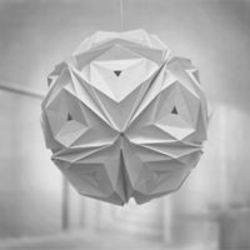Created and Sold by Jiangmei Wu

Booma Hexagon (L) - Pendants
Price $800
Creation: 2-4 weeks
Shipping: UPS 5-10 days
Estimated Arrival: May 27, 2024
| Dimensions | Weight |
|---|---|
12H x 24W in 30.48H x 60.96W cm | 0.91 kg 2 lb |
Hi-tec Kozo, stainless steel, LED
Folded from six pieces of paper. LED globe to provide warm and bright light.
Kawasaki Light Art is inspired by flat-foldable origami. In the Mathematics of paper folding, Kawasaki’s theorem, named after Toshikazu Kawasaki, gives a criterion for determining whether a crease pattern with a single vertex may be folded to form a flat figure. For a design to be completely folded into a flat figure, one of the requirements is that Kawasaki’s theorem must be satisfied at each vertex.
Each Kawasaki Light Art can be folded from a single piece of sheet material, in either Tyvek or Hi-tec Kozo. It can be folded into flat figures and can then be deployed into a three-dimensional volume. Therefore, Kawasaki lights can be shipped in small, flat, and light packages and can be easily assembled using plastic buttons.
Folded from six pieces of paper. LED globe to provide warm and bright light.
Kawasaki Light Art is inspired by flat-foldable origami. In the Mathematics of paper folding, Kawasaki’s theorem, named after Toshikazu Kawasaki, gives a criterion for determining whether a crease pattern with a single vertex may be folded to form a flat figure. For a design to be completely folded into a flat figure, one of the requirements is that Kawasaki’s theorem must be satisfied at each vertex.
Each Kawasaki Light Art can be folded from a single piece of sheet material, in either Tyvek or Hi-tec Kozo. It can be folded into flat figures and can then be deployed into a three-dimensional volume. Therefore, Kawasaki lights can be shipped in small, flat, and light packages and can be easily assembled using plastic buttons.
Have more questions about this item?